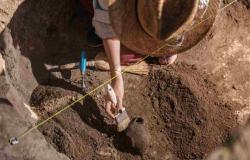From June 27th to January 13th 2025 is in existence, a Palazzo Madamathe exhibition Change! Yesterday, Today, Tomorrow. The Po which, together with a very broad territorial project, intends to deepen the theme of the climate crisisoffering a synoptic view of the millennial changes along the path of the Po rivera paradigm of what is happening on a global scale.
Addressing the essential themes of climate change in an exhibition that weaves a visual story entirely developed in the interaction between great painting and photography, illustration and infographics capable of narrating the Italian landscape in its complexity and articulation, from the Alps to the sea, the exhibition project focuses attention on the theme of water and in particular on ours Big Riverwhich has determined the landscape and the life of the population for thousands of years, is a communication route but also an essential support for agricultural and industrial activities, and explore the consequences e analyzes potential solutions implemented in the territory by the various research and protection bodies of the Po.
Six hundred and fifty-two ckilometers long, 141 tributaries, almost 87,000 square kilometers of drainage basin, 19,850,000 inhabitants, 37% of Italian agricultural production, 55% of the national livestock industry: the After and the Po Valley, where 40% of the national GDP is produced, constitute one of the areas with the highest concentration of population, industries and commercial activities in Europe.
This incredible development was made possible thanks to the historical stability and abundance of the flow of the waters of the largest river in Italy, which come from countless sources and diversified natural processes – mountain springs, snow melting, glaciers, large lakes and plain springs – but That in recent decades have seen a significant changeleading to a crisis phenomenon that is occurring everywhere globally.
Precisely because of its peculiarities and its carrying of memory, historical stratification and landscapes, the After – Roman and pagan, Byzantine and Lombard, feudal and lordships, countryside and cities, romantic, agricultural, industrial, tourist and cinematographic – is capable of portray the climate crisis and its effects in an emblematic and clearly perceptible way: the physiognomy of the planet is changing more rapidly than it has in the last millennia and the role that humans have played in this process is now demonstrated.
The exhibition in detail
The exhibition Change! aims to describe these changesoffering opportunities for reflection on the crisis and possible scenarios for adapting to itbut also of to urge action and to awareness: it’s time to act.
Dal strong scenographic and emotional impactthanks to the exhibition design by Emilio Alberti and Mauro Zocchetta, the exhibition opens with a formidable installation capable of projecting the landscape of ten million years ago, then narrated through the world of fossils, astonishing historical maps, infographics and original illustrations created by Jacopo Rosati, starting a story about the birth, history and evolution of the Po Basin first and of the Po afterwards, with a focus on the changes characterized by a secular trend and a sudden acceleration during the Anthropocene, our era.
The second section illustra natural life and human work in the Po basin area through photographs and paintings by great artists partly coming from the collections of the Civic Museums of Turinso as to underline the exceptional nature not only of the GAM heritage and Palazzo Madama, but also the historical funds ofPhoto Archive: oils, watercolours, etchings and temperas John Michael Graneri, Jean Louis Daudet, Joseph Pietro Bagetti, Antonio Fontanesi, Carlo Pittara, Joseph Pellizza from Volpedo and other great artists will be placed next to photographs by masters such as Vittorio Sella, Mario Gabinio, Riccardo Moncalvo, Franco Fontana, Mimmo Jodice e Brown Biaminoto restore fragments of daily life, traditions, activities and relationships of the people who live along the banks of the Po river, as well as outlining the Po Valley landscapes through the centuries.
All’Antropocene instead it is dedicated to the third section. Around 1950, the emission of large quantities of greenhouse gases reversed the neoglaciation process, generating a phase of anthropogenic climate warming, which is what the current drought of the Po tells us: the decrease in its flow, caused by the thinning of the Alpine glaciers, causes a decrease in the water reaching the Delta.
The story told through images by Mondoserie.it it is a crystalline example of the way in which man originally looked at the Earth and how this gaze has become progressively less far-sighted, to the point of losing sight of the overall horizon which, however, is now revealed with disruptive events.
The images of Adaptation.it they invite us to rediscover the ability to correct our own mistakes, to mitigate them, and the possibility for man to explore new solutions, giving space to his incredible ability to adapt to new, unexpected and often unfavorable situations, exploiting inventiveness, tradition and simple common sense.
The exhibition Change! fits into a plus large project that Palazzo Madama dedicates for the whole of 2024 to the themes of people’s rights and self-determination, the climate and Europe and represents the culmination of a reflection started in April with the Planet Week together with the World Bank on the occasion of the G7 Climate, Energy and Environment and developed through the exhibition Max Pinckers. State of Emergency and which will see collateral exposure activated Memories of water. Words and images by theItalian Linguistic Atlas; cycles of international conferences and conventions organized by thePo River District Basin Authorityfrom theDepartment of City Care, Public Green and River Banks of the City of Turin, with a thicket program of activities, workshops, laboratories and days at reduced rates which will involve the entire citizenry in the rediscovery and protection of the great water artery.
The exhibition, curated by Tiziana Caserta, Anna La Ferla e Giovanni CF Villawill be accompanied by a catalogue, published by Silvana Editorialwith contributions – among others – from scholars of theUniversity of Turindell’University of Bergamoof the Polytechnic of Turinof the Politecnico di Milanodell’AENEASOf Slow FoodOf Adaptation.it and of Mondoserie.it.






